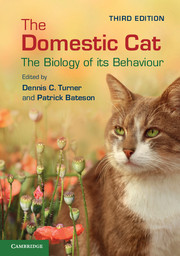Book contents
- Frontmatter
- Contents
- Contributors
- Abbreviations
- I Introduction
- II From Kitten- to Adulthood
- III Social Life and Ecology
- IV Cats and People
- V Cat Breeding and Cat Welfare
- 10 Feline welfare issues
- 11 Breed and gender behaviour differences: relation to the ancient history and origin of the domestic cat
- 12 Showing cats
- 13 Individual and environmental effects on health and welfare
- 14 Feline behavioural problems and solutions
- VI The Future
- References
- Index
14 - Feline behavioural problems and solutions
Published online by Cambridge University Press: 05 December 2013
- Frontmatter
- Contents
- Contributors
- Abbreviations
- I Introduction
- II From Kitten- to Adulthood
- III Social Life and Ecology
- IV Cats and People
- V Cat Breeding and Cat Welfare
- 10 Feline welfare issues
- 11 Breed and gender behaviour differences: relation to the ancient history and origin of the domestic cat
- 12 Showing cats
- 13 Individual and environmental effects on health and welfare
- 14 Feline behavioural problems and solutions
- VI The Future
- References
- Index
Summary
Introduction
Over the last decade or so, cats have moved into the position as the most common companion animal. The reasons are fairly obvious: they are known for being fastidious in eliminative behaviour – no necessity to take them on walks for elimination; they cuddle up next to us as we sit on the sofa; they can welcome visitors and they can even take care of the occasional vermin problem, should one arise. Cats have become ever more intimate family members, and they are an important source of emotional support for human family members. They provide ‘affection and unconditional love’ (Zasloff & Kidd, 1994). This is important for people who are depressed or isolated from others, those with special needs such as those restricted to a bed, and those caring for another person in a demanding role such as caring for a relative with Alzheimer’s (Hart et al., 2006).
The onset of a behaviour problem that interferes with the emotional support role of an otherwise loving cat, or even makes the cat intolerable to keep in the home, is particularly tragic. Fortunately, many behaviour problems that put the human–animal bond aspect of a companion cat at risk can be resolved or even prevented. The most serious of the problems is house soiling and this constitutes the most frequent category of behavioural problems in cats for which cat experts are consulted. Problems centring around aggressive behaviour are not as frequent as with dogs, but can become serious at times. A common problem for many cat owners is furniture scratching. Cats are increasingly kept indoors nowadays, especially in the USA and in urban areas, and eating house plants can be an issue both for the owners, who do not want their indoor garden messed up, and others whose cat may munch on a house plant or two that is poisonous.
- Type
- Chapter
- Information
- The Domestic CatThe Biology of its Behaviour, pp. 201 - 212Publisher: Cambridge University PressPrint publication year: 2013



